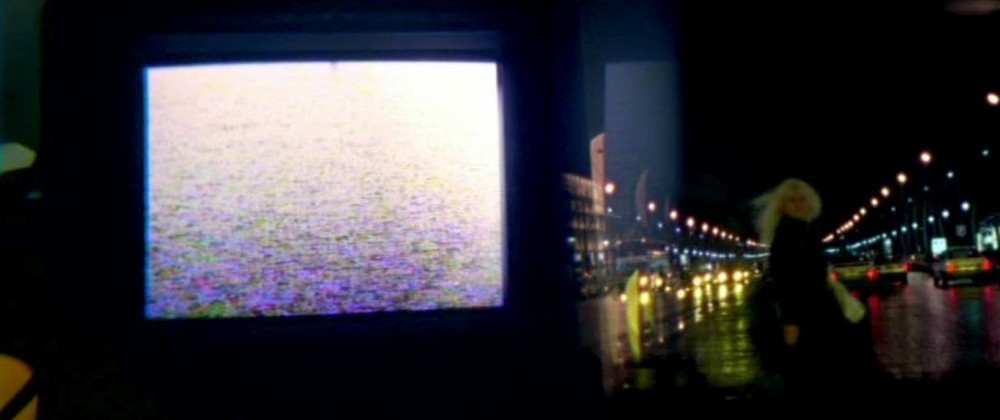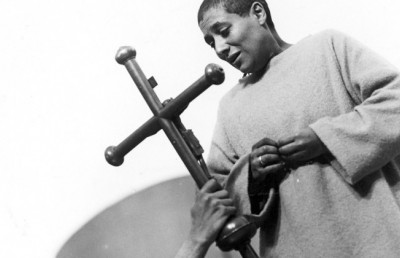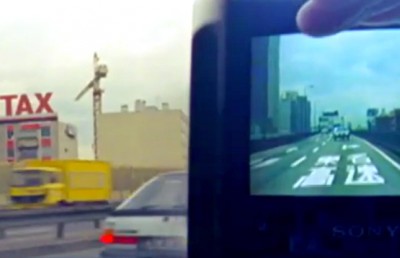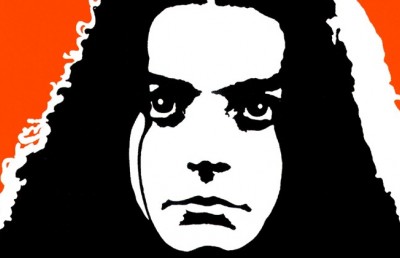The Ending(s) of Cinema: Notes on the Recurrent Demise of the Seventh Art, Part 2

Cinema’s Terminal Transition(s)
‘Transition’ has proven itself a persuasive teleological model on which to ground a terminal prognosis for the cinema, if only because of its vague definition and indeterminate temporality—one is always compelled to wait a bit longer for definitive evidence, thus making it difficult to refute the basic principles of the argument. A case in point, I have already noted that the past half-century of cinema in the age of television, almost always discussed in terms of a fierce competition—or at least an uneasy coexistence—between two rival media, has been put forth as perhaps the most sustained crisis of ‘transition’ undergone by the cinema. Film history is littered with instances, such as the advent in the 1950s of new techniques and gimmickry including 3D, cinemascope, and even a short-lived attempt, circa 1958, to add scents to motion pictures (“Smell-O-Vision” and “AromoRama”), that purportedly exemplify the cinema’s anxiety toward the possibility of losing its audience and its resultant obsolescence in the face of the newer medium. The decades hence have thus been construed as the lengthy ‘transition’ in question, with each successive development—from cable TV to consumer video, digital/satellite TV, ‘surround-sound’ home theater systems and HDTV—touted as the cinema’s ultimate death knell; however, I would argue that with these latter developments, the terms of the cinema/television debate have been somewhat redefined. No longer is the cinema’s demise considered a simple function of the movie theater losing its audience to television; rather, these recent discussions have resituated both cinema and television within a broader field of techniques and media that are in a (forced) process of mutation, their various elements converging and/or diverging in myriad ways. As the quote from Godfrey Cheshire quoted hereinbefore has stated, the new millennium would not be dominated by the two rival twentieth-century moving-image media, but rather said media would be drastically transformed via such technologies as “digital projection [. . .] live TV, interactivity, and a dazzling array of other novelties.” 1 This now-familiar argument is a compelling one; indeed, various new moving-image technologies, from CD-Roms to streaming video for the Internet, have captured a share of the entertainment audience; new media continue to evolve, borrowing from the aesthetics and techniques of both cinema and television. And the interrelationship (and interdependence) of cinema and television put forth by John Ellis, among others—with television relying on the cinema for its glamour, superior production values, narrative and characterization, etc. while the cinema relies on television for its money and its enormous audience 2 —has seemingly expanded its scope (and raised its stakes) with the advent of huge media conglomerates (such as AOL Time Warner) controlling vast global networks of divers media.
I will return to the question of media convergence/divergence in the next part of this essay, as the ‘transition’ described herein also corresponds at certain points to a historical parallel-in-reverse, or what I will term a ‘double-movement’. However, let me proceed by suggesting that the ‘transition’ I have detailed herein has entailed various reformulations of media history. I have already mentioned the tendency of much recent scholarship on early cinema to question the invention’s ‘inevitability’, emphasizing instead its very uncertain future within a diverse range of competing techniques and forms of popular entertainment at the turn of the twentieth century (more on this later). But what of the relationship between cinema and “pre-television”? According to Vito Zagarrio, the period from the early 1930s to the mid-1950s was marked by a determined tendency toward the mutation, convergence and divergence of the two media, with large-screen TV technologies developing in the 1930s, a video-to-film system devised by Paramount around the same time, the designing of small 400-seat cinemas to accommodate both film and TV presentation in the 1940s, the broadcasting of live horse races at the Pantages theater in Los Angeles and of other live entertainment at Paramount’s theaters in Chicago, and the proposed broadcasting of sporting events on TV systems to be installed in the theater chains of Loew-MGM, Fox and Warner. 3 It is very interesting to note that the counter-history presented by Zagarrio bears striking similarities to the post-cinema future postulated by Cheshire and other fin de siècle film critics.The death of cinema has also been postulated in relation to a much broader, systemic ‘transition’, to wit, the twilight of modernity. According to this logic, if the cinema was a product of an economic, technological and sociological configuration specific to modernity, the unraveling of this configuration at the end of the twentieth century must thereby also signal the end of cinema. Given the familiar argument that ongoing developments in image technologies—digital image manipulation and synthesis, CGI, etc.—have increasingly disengaged photography and cinema from ‘modern’ visuality and modes of spectatorship 4 , it is hardly surprising to note the recent tendency among scholars toward a reevaluation of the origin and place of these technologies within modernity itself. The question of the cinema spectator’s origin within a specifically modern regime of vision—and of the implications of the end of this regime—is explored by Jacques Aumont in his book L’Oeil interminable: cinéma et peinture. 5
Aumont’s argument challenges the successive film historiographies put forth by André Bazin’s “Myth of Total Cinema” 6 and by the “apparatus” theorists of the 1970s, which have frequently situated the cinema within a linear continuity extending back to the Renaissance and informed by a tradition of such visual models as the camera obscura’s monocular vision, geometrical perspective and a separation of viewer and spectacle. 7 In Aumont’s view, such a genealogy neglects significant, epistemic changes in visuality in the late-eighteenth and nineteenth centuries, including the shift from classical ‘disembodied’ spectatorship to a ‘corporeal’ gaze, and the range of techniques and cultural practices that indicate the emergence of a new, ‘modern’ regime of vision, such as photography, the panorama, mountain climbing and rail travel. 8 Conversely, modern visual culture does not begin with photography, but rather with a key transition in painting between 1780 and 1820: the ébauche, a measured and deliberate preparatory drawing from the artist’s notebook, gives way to the étude, a rapidly-executed sketch that attempts to capture a fleeting and mobile reality. Thus for Aumont, the socio-historical preconditions for the cinematic spectator are not the models, techniques and practices corresponding to ‘classical’ visuality, but rather the transient and virtual features of modern visual culture as experienced through the embodied, ‘corporeal’ gaze, or what he terms l’oeil variable, a gaze that is subject to continual historical variability. The exhaustion of this regime of vision and the transition toward a ‘postmodern’ spectator would thus seem to suggest that the cinema itself is moving toward its end. As Charles O’Brien has written:
The “schematized, synthesized, hypersignifying” forms of representation now prominent in film and television suggest that the variable eye, “the modern configuration par excellence,” is now ceding place to a new “cold eye,” “completely without reference to the human who embodies it.” […] At issue is clearly not a return to the separation of viewer and spectacle characteristic of classicism. Among Aumont’s examples of today’s “demobilized” eye is the cyberspace of certain video games, in which the surgical penetration of the subject that Benjamin described a propos of the age of mechanical reproducibility would seem to approach a limit. Here the viewer engages with a virtual reality to the degree that the notion of “textual mediation”—implying essential differences between subject and object, inside and outside—scarcely applies. 9
Film History as Double-Movement
In the early days […] not only were films slotted into vaudeville bills between braying comics, dancing mules and third-rate acrobats—and you could talk back to everything on the program: call it pre-electronic interactivity—but also the people who supplied the movies tried everything they could think of, from scenes of distant countries to fake train trips to in-camera magic tricks to historical re-creations. […] Immediately after digital’s arrival, expect another spell of wide open experimentation until the new medium’s modalities and audience tastes are sussed and locked in. 10
If video images sacrifice the photograph’s contemplative stance toward reality, CGI dispenses with reality altogether. […] Inevitably, every CGI movie returns us to one basic conundrum: if the world is unreal, where does that leave the viewer? Is he not just as empty and spectral—a mirror held up to a flickering void? […] From earliest infancy children are barraged with electronic images and information that comprise an amazingly comprehensive and irresistible system of brainwashing, if you’ll pardon the term. Here, “knowledge” is based not on experience but on inculcation, and not on the real world but on images that reduce the world to an endless streaming of emotionally charged and ideologically weighted abstractions. 11
The shift towards virtual reality is a shift from one type of thinking to another, a shift in purpose which modifies, disturbs, perhaps even perverts man’s relation to what is real. […] All good films, we used to say in the 1960s, when the cover of Cahiers du cinéma was still yellow, are documentaries, […] and filmmakers deserved to be called ‘great’ precisely because of their near obsessive focus on capturing reality and respecting it, respectfully embarking on the way of knowledge. [Today, on the other hand], cinema has given up the purpose and the thinking behind individual shots, in favour of images – rootless, textureless images – designed to violently impress by constantly inflating their spectacular qualities. 12Conclusion: Intermedia/Multimedia/Hypermedia and the Fate of the Cinematic Image I’d like to take the last part of this essay to address the question of how the various logics and discourses I have elaborated herein—that is to say, these different historical reflections and substantive material transformations in the domain of the moving image—have in recent decades initiated and informed new modes of reception and ‘intermedia’ practices, especially with regard to the displacement of the cinematic image from its traditional context. As I have noted, one identifiable preoccupation within this discourse has been with the question of the possibility of the cinema’s ‘renewal’ or ‘revitalization’; for instance, in a lecture delivered at the Tate Modern earlier this year (under the title “Keeping the Dead Alive”), Laura Mulvey has spoken of the new possibilities for reception and interpretation brought about by new technologies, in particular the VCR (rewind, freeze-frame, fast-forward) and how these new venues and possible practices of reception might re-invigorate film-historical discourse in the future. 17 Mulvey illustrated her point by repeatedly showing a sequence of Douglas Sirk’s Imitation of Life (1958) and showing how an active viewer might pick up on a fleeting instance of structured sexual positioning not normally perceptible in the context of a single, straight linear viewing. Mulvey’s point is well taken, regardless of the minimal likelihood that many lay viewers will dissect this or any other film in the way a CD-Rom or other new medium lends itself to interactive reception—after all, the VCR is certainly not a new technology. What interests me however, is the possibility that intermedia practices, particularly the work of myriad multimedia artists appropriating and/or producing cinematic texts and displacing them into visual arts environments—what Jean-Christophe Royoux has termed cinema d’exposition 18 — are in fact the site where the cinema history is carried forward in the way Mulvey suggests; in this context one cannot resist noting a certain irony in the words of the Scottish artist Douglas Gordon: “Le cinéma est jeune, il n’a que cent ans, mais pour nous il est déjà mort.” 19
I would like to close with two examples from contemporary ‘cinematic’ visual art practice, two works by artist Mark Lewis, in order to illustrate how this development in the visual arts is underpinned by the very discourses I have been discussing herein, to wit, the veritable obsession with the “end” of cinema and with what might remain after its inevitable demise. I choose these works also because they invoke another figure of the ‘end’ in cinema that I have not heretofore introduced, the question of inherent narrative, shot and textual ‘endings’ in the filmic medium; the two works I want to discuss are Upside Down Touch of Evil (1997) and A Sense of the End (1996).
Over the past decade, Lewis has produced an extensive series of film-based works, shot mostly in 35mm and typically transferred to DVD for the purposes of single- or multi-channel gallery installation. While Lewis’s film works have superseded his earlier, long-term practice in the area of public art and monuments, this abrupt shift somewhat conceals the overall unity of his artistic concerns: in both cases, Lewis is interested in modern historical projects that aspire to what he considers the artistic “impossibility” of serving as a “total art of the people.” 20 Moreover, Lewis is specifically interested in the circumstances that attend the decline of a given object, be it the public monument or cinema.
In A Sense of the End, which is presented as a continually looping film installation projected on two adjacent screens, Lewis assembled a series of short narrative clips, each of which he had staged and shot to appear like the ultimate sequence of some familiar, yet non-existent motion picture. Manipulating the syntactic and referential logic of mainstream narrative cinema, this piece creates in the viewer a peculiar sense of déjà vu, as this series of film “endings”—drawing on all of the Hollywood clichés and conventions to which we are accustomed—presents us with instantly-recognizable finales for films we think we may have seen (but in fact have not). As such, A Sense of the End situates this experience of recognition within the fragmentary, delocalised contexts of reception characteristic of many contemporary situations; for example, glimpsing the end of a film while flipping through television channels, in the video store, etc.
Upside Down Touch of Evil presents a somewhat more complex reflection on the figures I have examined hereinbefore: this piece is a “remake” of the famous opening of Orson Welles’s film A Touch of Evil (1957), which consists of a three-and a-half-minute single shot (plan séquence), only Lewis’s version was filmed with the camera mounted upside down. Upside Down Touch of Evil evokes the “end of cinema” on several levels: like A Sense of the End, it appropriates the industrial mode of production of commercial cinema while displacing the cinematic image into a “post-cinematic” visual arts context. Like the latter work as well, it manipulates the syntactic conventions of narrative cinema—while A Sense of the End plays on the notion of the inevitable narrative and textual ending of motion pictures, Upside Down Touch of Evil is concerned with the durational nature of the single shot and its inevitable ending, the deferral of which is exploited to exhilarating effect by Welles and scores of other filmmakers throughout the history of cinema. 21 As well, the inversion of the camera is, for Lewis, designed by reference to the iconoclastic practice by the 16th-century Huguenots of turning pictures upside down, thus linking the immanent, if metaphorical, negation of art works in Modernism—“Fontana’s slit canvases. Rauschenberg: ‘Erased De Kooning.’ Arnulf Rainer: painting over extant canvases. Tinguely’s ‘machine for breaking sculpture.’ Man Ray’s ‘Object to be destroyed,’ and so on” 22 — to the demise of cinema and its attendant discourses. In conclusion, the work of Lewis and other contemporary multimedia artists represents a range of highly sophisticated meditations on the past and future of the moving image and the figures of its death in relation to art and visual culture; the historicist outlook underpinning these intermedia approaches are perhaps best revealed by Lewis’s own words:
As far as the future of film is concerned… well, it seems to me that almost all art of this century has been formed in relationship to the emergence of cinema. Even in defiance, art has had to, and has wanted to, react to and produce itself in relationship to what we might call the cinematic effect. Artists have been part of that so-called universal audience of film. They’ve felt its effect. They’ve felt that dream. That dream is history now, but it won’t go away. Perhaps with the shift of cinema onto the historical stage, artists can now treat it like an object rather than a phenomenon. […] I think art in this context is a secondary invention performed upon another invention, which is already a bit dusty. 23
Read Part 1 Here.
Works Cited
Aumont, Jacques. L’Oeil interminable: cinéma et peinture. Paris: Séguier, 1989.
Bazin, André. What is Cinema? Vol. 1. Hugh Gray, ed. and trans. Berkeley and Los Angeles: University of California Press, 1967.
Bellour, Raymond. L’Entre-Images 2: Mots, Images. Paris: P.O.L., 1999.
Bloemheuvel, Marente, and Jaap Guldemond. Cinéma Cinéma: Contemporary art and the cinematic experience. Eindhoven: Stedelijk Van Abbemuseum, 1998.
Boussinot, Roger. Le Cinéma est mort, vive le cinéma. Paris: Denël, 1967.
Charney, Leo, and Vanessa R. Schwartz, eds. Cinema and the Invention of Modern Life. Berkley and Los Angeles: University of California Press, 1995.
Cheshire, Godfrey. “The Death of Film/The Decay of Cinema.” New York Press, vol. 12, no. 34 (26 August 1998). Online at http://www.nypress.com/12/34/film/film3.cfm.
Dixon, Wheeler Winston. The Second Century of Cinema: The Past and Future of the Moving Image. Albany: SUNY Press, 2000.
Elsaesser, Thomas and Kay Hoffmann, eds. Cinema Futures: Cain, Abel or Cable? Amsterdam: Amsterdam University Press, 1998.
Gunning, Tom. “‘Primitive’ Cinema: A Frame-Up? Or the Trick’s on Us.” Thomas Elsaesser, ed. Early Cinema: Space – Frame – Narrative. London: BFI, 1990. 95-103.
Harvey, Sylvia. “What is Cinema? The Sensuous, the Abstract and the Political.” Christopher Williams, ed. Cinema: The Beginnings and the Future. London: University of Westminster Press, 1996. 228-52.
Kermode, Frank. The Sense of an Ending: Studies in the Theory of Fiction. New York: Oxford University Press, 1967.
Leprohon, Pierre. Histoire du cinéma muet: vie et mort du cinématographe (1895-1930). Paris: Éditions d’Aujourd’hui, 1982.
Lewis, Mark. “Some Sense of an End.” Marie Fraser, Diane Gougeon and Marie Perrault, eds. Sur l’expérience de la ville : Interventions en milieu urbain. Montréal: Optica, 2000. 141-51.
Mitchell, William J. The Reconfigured Eye: Visual Truth in the Post-Photographic Era. Cambridge, Mass. and London, U.K.: MIT Press, 1992.
Mulvey, Laura. “Keeping the Dead Alive.” Lecture delivered at the Tate Modern, London. 7 March 2002.
Nichols, Bill. Blurred Boundaries: Questions of Meaning in Contemporary Culture. Bloomington: Indiana University Press, 1994.
O’Brien, Charles. “The End of Cinema? An Afterword to Jacques Aumont’s ‘The Variable Eye.’” Dudley Andrew, ed. The Image in Dispute: Art and Cinema in the Age of Photography. Austin: University of Texas Press, 1997. 259-62.
Païni, Dominique. Le Cinéma : un art moderne. Paris: Cahiers du cinéma, 1997.
Russell, Catherine. Experimental Ethnography. Durham, NC: Duke University Press, 1999.
Sontag, Susan. “The Decay of Cinema.” New York Times, 25 February 1996. 1-2.
Usai, Paolo Cerchi. The Death of Cinema: History, Cultural Memory and the Digital Dark Age. London: BFI, 2001.
Witt, Michael. “The Death(s) of Cinema According to Godard.” Screen, 40.3 (Autumn 1999). 331-46.
Notes
- Cheshire, “The Death of Film/The Decay of Cinema.” ↩
- John Ellis, “Cinema and Television: Laios and Oedipus,” in Thomas Elsaesser (ed.), Cinema Futures: Cain, Abel or Cable?, 127. ↩
- Vito Zagarrio, ”Theseus and Ariadne: For a Counter-History of the Cinema-Television Relationship?” in Elsaesser and Hoffmann (eds.), Cinema Futures: Cain, Abel or Cable?, 88-89. ↩
- See for example William J. Mitchell, The Reconfigured Eye: Visual Truth in the Post-Photographic Era (Cambridge, Mass. and London, U.K.: MIT Press, 1992). ↩
- Jacques Aumont, L’Oeil interminable: cinéma et peinture (Paris: Séguier, 1989). ↩
- See André Bazin, “The Myth of Total Cinema,” in What is Cinema? Vol. 1, ed. and trans. by Hugh Gray (Berkeley and Los Angeles: University of California Press, 1967) 17-22. ↩
- Charles O’Brien, ”The End of Cinema? An Afterword to Jacques Aumont’s ‘The Variable Eye’”, in Dudley Andrew, (ed.), The Image in Dispute: Art and Cinema in the Age of Photography (Austin: University of Texas Press, 1997), 259. This anthology includes an English translation of the second chapter of Aumont’s L’Oeil interminable. ↩
- Ibid. ↩
- Ibid., 261. ↩
- Cheshire, “The Death of Film/The Decay of Cinema.” ↩
- Ibid. ↩
- From a press handout of Douchet’s lecture at the conference Le Cinéma: Vers son deuxième siècle held at the Odéon, Paris, 20 March 1995, 1. Quoted in Thomas Elsaesser, “Louis Lumière – the Cinema’s First Virtualist?” in Elsaesser and Hoffmann (eds.), Cinema Futures: Cain, Abel or Cable? 45. ↩
- See Thomas Elsaesser, “Louis Lumière – the Cinema’s First Virtualist?” in Elsaesser and Hoffmann (eds.), Cinema Futures: Cain, Abel or Cable? 45-61; Tom Gunning, “’Primitive’ Cinema: A Frame-Up? Or the Trick’s on Us,” in Thomas Elsaesser (ed.), Early Cinema: Space – Frame – Narrative (London: BFI, 1990), 95-103. ↩
- See for example Bill Nichols, Blurred Boundaries: Questions of Meaning in Contemporary Culture (Bloomington: Indiana University Press, 1994); Catherine Russell, Experimental Ethnography (Durham, NC: Duke University Press, 1999). ↩
- Dixon, The Second Century of Cinema: The Past and Future of the Moving Image, 4. ↩
- Lewis writes: “If modernism banned iconoclasm, at least in its material sense of actually destroying works, iconoclasm continues as a metaphorical a priori of Modernism: Literally to destroy what has come before becomes the imperative that drives autonomous modern art toward its end.” Mark Lewis, “Some Sense of an End,” in Marie Fraser, Diane Gougeon and Marie Perrault (eds.), Sur l’expérience de la ville : Interventions en milieu urbain (Montréal: Optica, 2000), 145. ↩
- Laura Mulvey, “Keeping the Dead Alive,” lecture delivered at the Tate Modern, London, 7 March 2002. ↩
- Jean-Christophe Royoux, “Remaking Cinema,” in Marente Bloemheuvel, and Jaap Guldemond, Cinéma Cinéma: Contemporary art and the cinematic experience (Eindhoven: Stedelijk Van Abbemuseum, 1998), 21. ↩
- Douglas Gordon, ”Entretien avec Stéphanie Moisdon,” Bloc Notes, no. 11, janvier-février 1996. Quoted in Raymond Bellour, L’Entre-Images 2: Mots, Images (Paris: P.O.L., 1999), 267-68. ↩
- Lewis, “Some Sense of an End,” 146. ↩
- Consider for instance such famous long takes as those in Kalatazov’s Letyat Zhurlevi (The Cranes are Flying) (1958) and I Am Cuba (1962); Tarkovsky’s The Sacrifice (1986); Scorsese’s GoodFellas (1990), etc. ↩
- Lewis, “Some Sense of an End,” 145. ↩
- Mark Lewis, “A Sense of Disbelief” (Interview with Charles Esche), in Bloemheuvel and Guldemond, Cinéma Cinéma: Contemporary art and the cinematic experience, 105. ↩



-resize-crop_400_258_90_s_c1.jpg)









